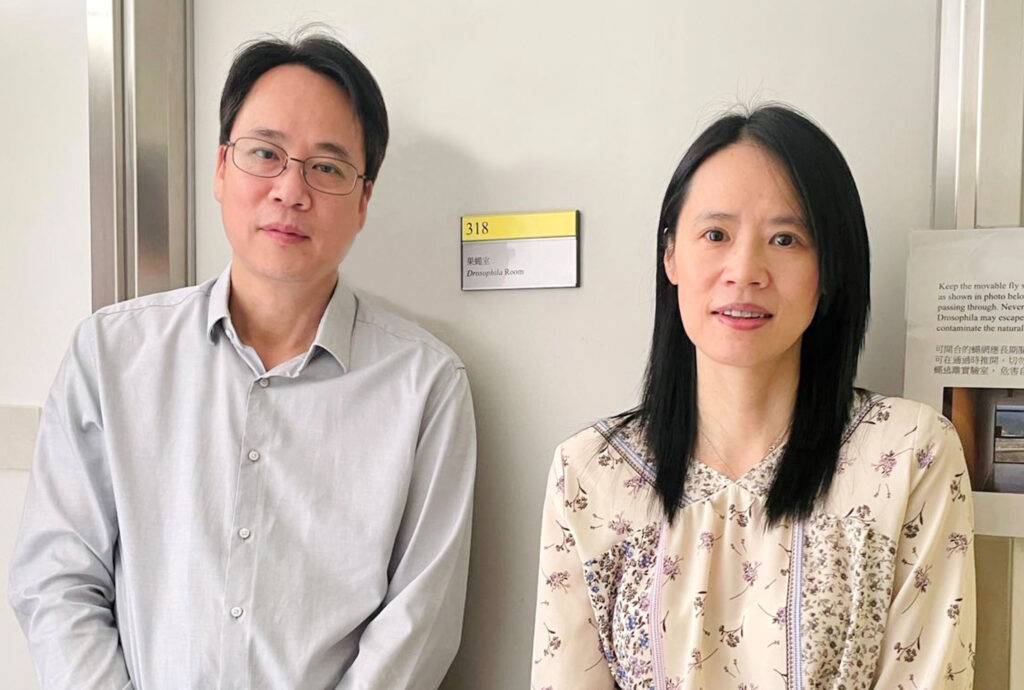CUHK
News Centre
CUHK discovers a neural architecture that facilitates the formation of associative memory, providing the basis for a deeper understanding of memory and its impairment in brain disorders
Neuroscientists from the School of Biomedical Sciences in The Chinese University of Hong Kong (CUHK)’s Faculty of Medicine (CU Medicine) have discovered a new neural architecture in the brain of the fruit fly that facilitates the formation of associative memory. The findings provide a good foundation for understanding memory problems caused by neurodegenerative diseases and help develop effective therapeutic strategies for brain disorders. The results of the study were recently published in the renowned scientific journal Current Biology.
Studying the mechanism of memory formation is difficult due to the complex structure of the brain
Almost all the things we know and do are because of our memory, which is formed by experience. Brain disorders that affect the memories of people such as Alzheimer’s disease patients can also deprive them of their identity and sense of meaning in life. Decades of research have discovered that the mammalian brain’s hippocampus is critical in the formation of memory. Pathological changes occur in the hippocampus of patients who have Alzheimer’s and other diseases, leading to the inability to form new memories. However, studying the mechanism of memory formation by the hippocampus in humans and other mammals is notoriously difficult because of the enormous complexity of the mammalian brain.
In the brain of the fruit fly, Drosophila, a structure called mushroom body plays a similar role to that of the hippocampus in the mammalian brain but is much simpler in cellular composition and organisation. Therefore, the fruit fly is a popular model for neuroscientists to study memory. In the current study, the research team from the School of Biomedical Sciences at CU Medicine has uncovered a novel neural architecture in the mushroom body of a fruit fly that drives efficient memory formation.
Using the fruit fly’s tiny brain to unravel a novel neural architecture for memory formation
Fruit flies can easily learn to associate the occurrence of an otherwise neutral odour with the experience of an electric shock, resulting in subsequent avoidance of the odour. The team applied technically very challenging neural recordings and neuroimaging from the exceedingly tiny brains of the fruit flies. They discovered a novel form of neural plasticity, an ability of neural networks in the brain to change through growth and reorganisation according to experiences, in the input stage of mushroom body neurons. This plasticity depends on the precise order and arrival times of the odour and electric shock.
By generating different genetically modified fly lines, the research team went on to show that this plasticity is exhibited only by a specific population of neurons and is essential for forming aversive olfactory memory. The highly plastic synaptic connection at the input site together with the well-reported connection at the output site of the mushroom body represents a novel neural architecture for memory formation.
Dopamine and its receptor are essential for associative memory formation
Another finding of this study is the role played by dopamine and its receptor. The team found that the plasticity essential for associative memory formation is enabled by a group of neurons that release dopamine to activate specific dopamine receptor subtypes in the mushroom body. This action on the circuitry increases the salience of the stimulus and tightly couples the process of memory encoding to drive associative learning. Therefore, it facilitates the assignment of the “meaning” of a sensory stimulus in the animals that influences their behaviour. Since dopamine deficiency is a characteristic of many neurodegenerative diseases, the results provide a good foundation for understanding memory problems caused by these disorders.
Professor Ke Ya, Associate Professor at CU Medicine’s School of Biomedical Sciences, remarked, “Associative learning is the foundation of more complex forms of learning. This circuit architecture, or its working principle, may be preserved and utilised in the brains of higher animals. Therefore, our study has provided a deeper understanding of memory formation in the animal brain. Our results may also inspire researchers in the field of artificial intelligence to design new artificial neural networks that can learn faster and better.”
Professor Yung Wing-ho, Professor from the School of Biomedical Sciences at CU Medicine, noted, “Probing what goes wrong with the memory of brain disorder patients relies on an appreciation of the normal process of memory formation. Our discovery of the regulatory mechanism in memory formation may in the future be important for the development of effective therapeutic strategies for Alzheimer’s disease and other brain disorders.”
The study was led by Professor Ke Ya and Professor Yung Wing-ho, with contributions by Mr Qiao Jing-da, Mr Yang Sheng-xi and Dr Geng Hong-yan.





